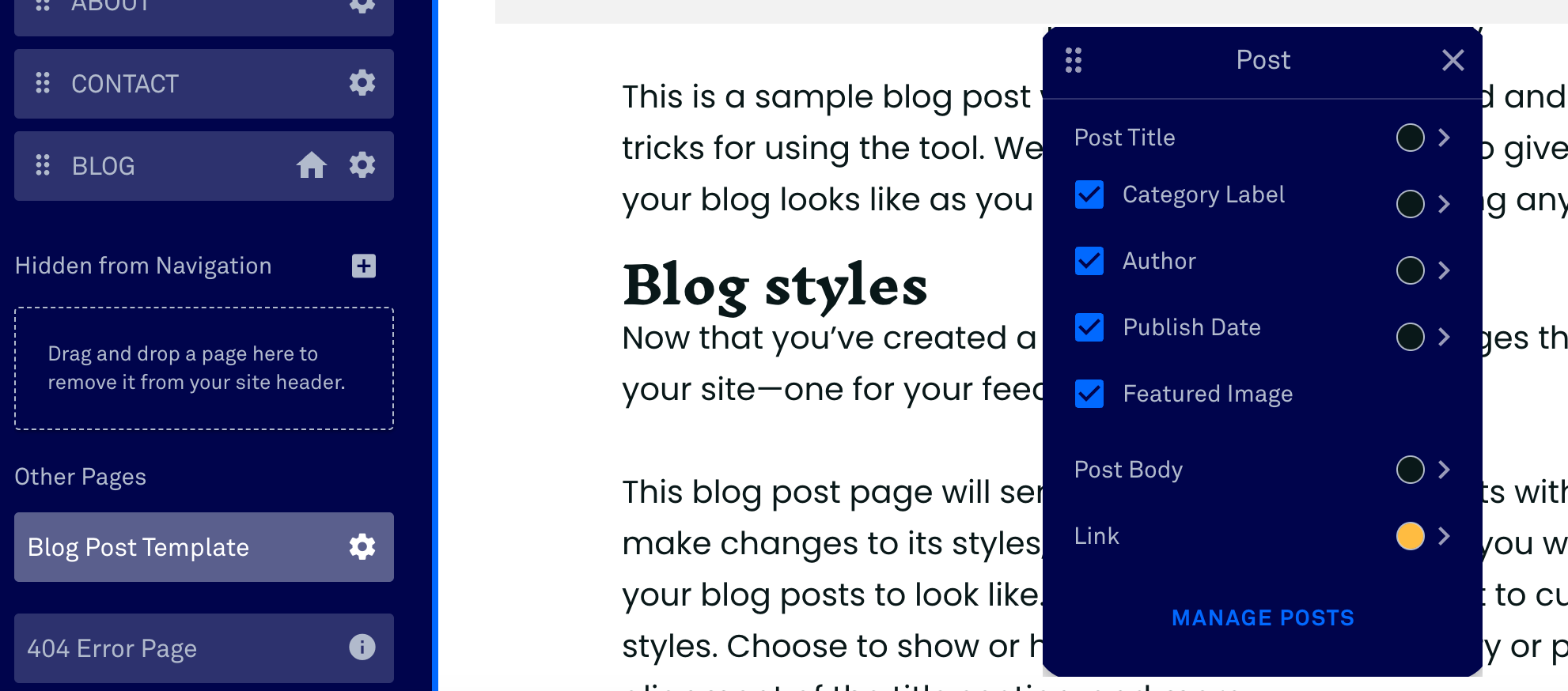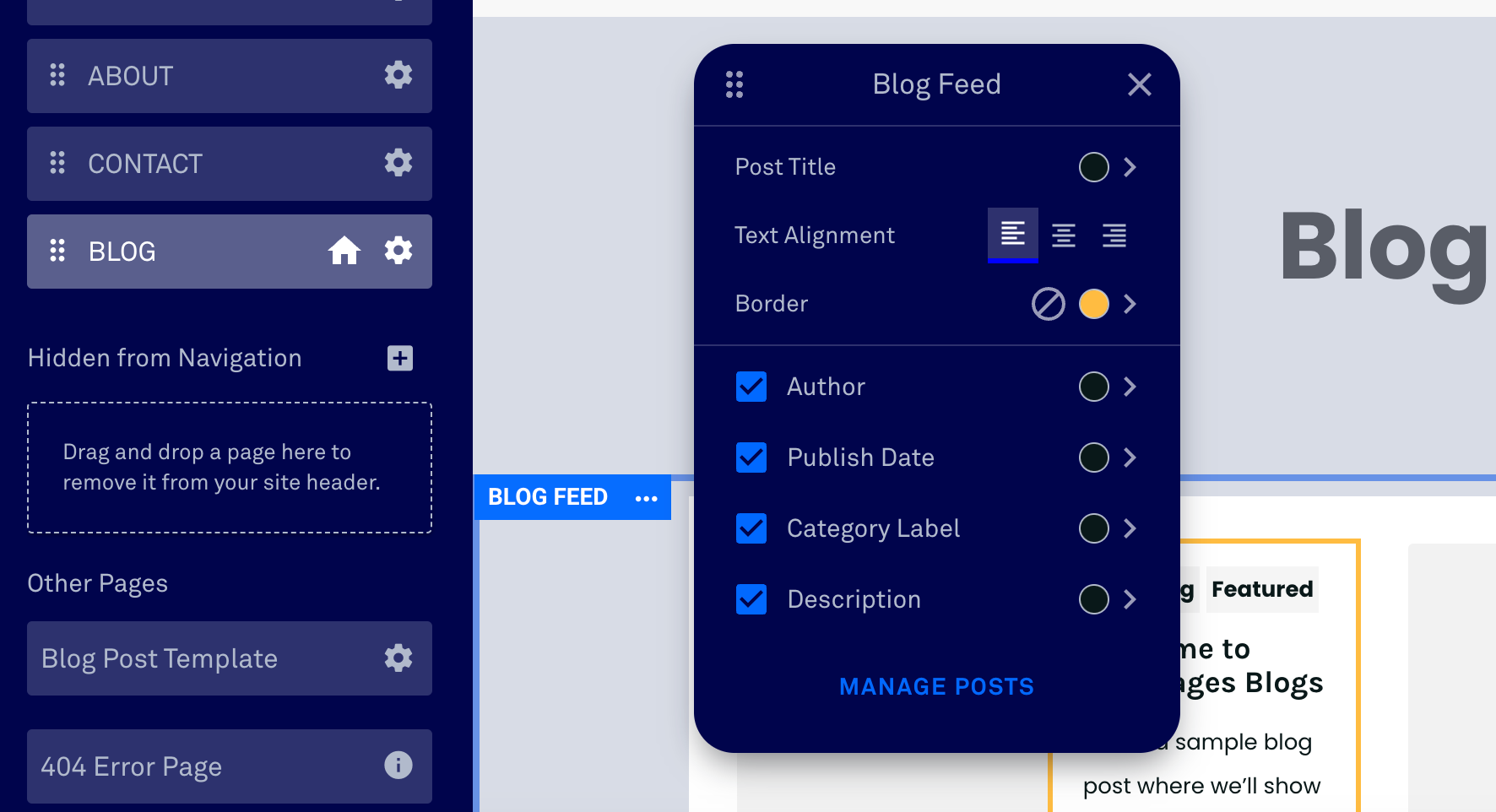This is a sample blog post where we’ll show you around and share our tips and tricks for using the tool.
Editing
You’re currently in the blog post editor where you will create and publish post content. Above you’ll see a text editor that gives you full customization with your content. You can edit text styles, create lists, insert images or videos and more. To the right is where you can upload a featured image for the post or choose an existing one from your account’s image library.
Make sure to Save your changes before leaving the editor.
Authors and categories
Add an author to your post from the right sidebar to give writing credit to the creator. You can also add categories to your posts to give your visitors an easier way to filter your posts by the topics they’re most interested in.
Authors and categories can also be added from the larger Authors and Categories menus on the left sidebar navigation.
Publishing
When you’re finished with your post, you have the option to schedule the post to be published at a specific date and time or publish it immediately. Select your choice from the top-right corner of the post editor, then click to schedule or publish.
If you’d ever like to place your post back in draft, simply select Draft and save.
Blog styles
To edit the template styles of your blog, you can navigate to the Leadpages site your blog is connected to, or from Blogs in your account navigation menu, select Edit Template Styles next to the blog you would like to edit.
Two site pages will control the look and feel of your blog, one for your blog feed and one for posts.
This blog post page will serve as a template for all posts within your blog. As you make changes to its styles, this sample post will show you what you can expect your blog posts to look like. Click anywhere on the sample post in the builder to customize your post styles. Choose to show or hide post details like category or publish date, change the alignment of the title section and more.

The blog feed page will serve as the homepage for your blog, where your posts will be presented on a grid for your visitors to explore. The feed page will use this sample post to represent the content on your feed. Click anywhere on the feed and you can change your feed layout, decide which post details you would like to show or hide, and more. The page also acts similarly to other site pages, so you can place it in your primary navigation or hide it, as well as use the Layout area to edit its background and other styles. Click preview once you’ve made changes to see how they’ll look with your content.

Best practices
New to blogging? Here are a few best practices to follow to ensure your blog reaches as many people as possible.
How often should I write a new blog post?
As often as you like—as long as you’re posting quality content. As with most things, quality is more important than quantity. That being said, try to keep to a regular publishing schedule, whether that be every other week, once a month, or whatever works for you. That way, your followers know when to expect new content from you.
How should I style and format my blog?
The most important thing to think about when it comes to blog styling is readability. This starts with your font. Choose a sans serif font for your body text, as these are generally easier to read. You can pair that with a serif font for your H1 and sub-headers to add a little style. Speaking of sub-headers, use them often to break up your text. You should also keep your paragraphs short (three to four lines). This creates more whitespace and makes your blog look less intimidating.
How long should my blog posts be?
Google recommends that any content that you want to be found in search engines be at least 300 words. In reality though, to give your blog posts the best chance of appearing in search results you should aim for 1,500 - 2,000 words. A good rule to follow is to simply write as many words as necessary to cover your topic in full. More words are generally better, but don’t add fluff and filler just to reach an arbitrary word count.
Should I consider reading level?
You might be surprised to learn that most people read at an 8th-grade level. So save the big words for your English essay and keep things relatively simple when it comes to your blog. The best approach is to just write like you speak. Imagine yourself describing your topic to your friend and write like that.
How do I get my blog posts to show up in Google?
Search engine optimization (SEO) is definitely something you should consider when writing your blog posts. The best way to get your posts ranked in Google is to target a specific keyword or phrase with each post and use it throughout (when it makes sense). Your keywords should be relevant to your business and be actively searched by your ideal customer. There are several free and paid keyword tools you can use to find the right keywords for your blogs. For more SEO tips, check out this article.
Should I include images and videos in my blogs?
Absolutely. Not only do images and videos add additional context and value to your content, but they also serve as another way to break up your text. Plus, including relevant media in your blogs helps with SEO. Just be careful about including copyrighted content. Free stock image sites like Pexels and Pixabay are great places to find royalty-free images, or you can purchase premium stock images right in your Leadpages account. You can also embed any YouTube video within your blog post, but to ensure you’re always promoting your own brand use your own videos whenever possible.
Any common SEO pitfalls when blogging that I should know about?
The biggest mistake bloggers can make is writing for search engines instead of people. First off, search engines like Google have become smart enough to tell when you’re just stuffing keywords into your post as much as possible. But even worse, when people land on your post and realize it’s just a bunch of keywords and doesn’t actually provide any value they’ll quickly leave. And metrics like bounce rate and time on site are things search engines now take into account when ranking pages. So if no one is actually reading your content you won’t rank for any keywords.
What are some other ways to drive traffic to your blog posts?
SEO isn’t the only way to get traffic to your blog. The first thing you should do after you post a blog is share it across all your social channels. Even if you don’t have a big following you never know who will like and share it. If you have an email list or a newsletter make sure to include it there as well. Guest posting is another way to get some exposure to your blog. This is where you post content on other people’s blogs, with the agreement that you can link back to your own blog.
How might I use AI when blogging?
AI is definitely a useful tool when it comes to blogging. You can use it to brainstorm ideas, find keywords, create an outline, and even write some of your content. However, if you plan on letting AI write your entire post for you, you might want to reconsider. While AI writing software is rapidly improving, the content it produces will often need at least some editing. AI also draws its information from existing sources, which means the information it provides isn’t anything new or original (and isn’t always factually correct). At the very least, you’ll need to provide your own ideas and finesse the text to make it sound more human. When using AI, it’s best to treat it more like an assistant, rather than the primary writer.